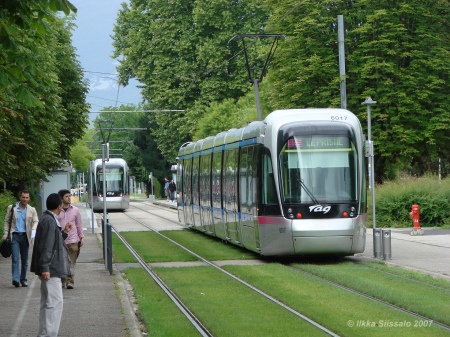
Grenoble France, with a regional population of 580,000 completed it’s first a modern tramway line in the 1987, after a successful, but hard fought civic referendum and has set the standard for modern LRT not just in France, but for the EEC. The first tram (streetcar) line, Line A, currently 13 km with 29 stops, opened, followed by Line B , with 9 km with 20 stops in 1990. The two lines share a section of route from the railway station to the city center; at this point Line B leaves Line A and turns east towards the city hospital and the university campus (5.8 km). In 1996 Line A was extended in south towards Echirolles (3.4 km), two years later (1998) another section was added with the new terminal of Denis Papin (0.4 km). The extensions were completed by another branch which traveled west to connect the railway station to Europoles business district; and more tram extensions are in their final stages of planning or have been just completed: Citè Internationale al Polygone Scientifique (Line B, to be opened in 2009), La Poya-Sassenage (Line A, with works starting in 2013), Denis Papin-Pont-de-Claix Line A, with works starting in 2013).
A third tram line (Line C: 9.6 km, 16 stops) opened in 2006; it runs from Seyssins Le Prisme to Saint-Martin d’Heres Condillac Universites connecting Grenoble to the suburban areas of Seyssins, Seysinnet, St Martin d’Heres and Gieres (which will assume a strategic role thanks to the high speed railways Turin-Lyon). Line D followed in 2007, with a north-south section (2.6 km, 6 stops) from Saint Martin d’Heres to the University District, passing through Gabriel Peri and Renaudie quartiers; and an extension from Saint Martin d’Heres to Grand Place and Meylan is in the final stages of planning.
A fifth line (Line E) should complete the network for now, replacing (after 2012) a trolley-bus existing line from Fontanil a Cornillon.
Grenoble’s tramway is considered one of France’s best and became the model for Paris’s Renaissance building with LRT and other cities in the country. The introduction of low-floor cars also has set the standard for new light rail vehicles, with modern streetcars or trams, with few exceptions, are designed to be low-floor. Not only low-floor LRV’s speed up dwell times (as originally planned), they have proven to be a great boon for the mobility impaired, providing accessible public transit, on the street, ready to use, with out fear of large metro stations with crowded elevators that may or may not be in service. It was the low-floor tram that forced bus makers to provide low-floor buses to complement trams and to compete against streetcars.

| Country | France |
| Line | Line A, Line B, Line C, Line D |
| Inhabitants | City 150.000, District 350.000 |
| Date opening | 1987 Line A, B (with extensions in 1996-1998); Line C: 2006; Line D: 2007 |
| Future development: | Line E (Fontanil-Cornillon); extensions: Line A (La Poya-Sassenage, Denis Papin-Pont-de-Claix), Line B (Citè Internationale-Polygone Scientifique), Line D (Saint Martin d’Heres-Grand Place-Meylan) |
| Length (km) | 34.2 |
| Track sections | Line A: 13 km; Line B: 9 km; Line C: 9.6 km; Line D: 2.6 km |
| Stops | 71, average distance 500 m (Line C) |
| Platforms | — |
| Platform doors | — |
| general characteristics | — |
| n. of vehicles | 88 (TFS: 53; Citadis: 35) |
| n. of cars per vehicle | — |
| Type | steel wheels bidirectional |
| Vehicle dimensions (m) | length TFS: 29.40, Citadis: 43.73; width TFS: 2.30, Citadis: 2.40 |
| Vehicle capacity (pax) | TFS: 178 (52 seated);Citadis: 274 (76 seated) |
| Frequency | — |
| Current/Voltage | 750 V DC overhead |
| Guide/gauge | standard gauge rails (1435 mm) |
| Speed Km/h | Comm. –, Max 70 |
| Accel./Decel. (m/sec2) | — |
| System capacity | — |
| Ridership | 230.000 pas/day |
| Total cost | — |
| Staff | — |
| System builder | ALSTOM |
| Model | Tramway Francais Standard (TFS), Citadis 402 |
| NOTE | TFS trains used in Line A, C, D; Citadis trains used in Line B, C |
